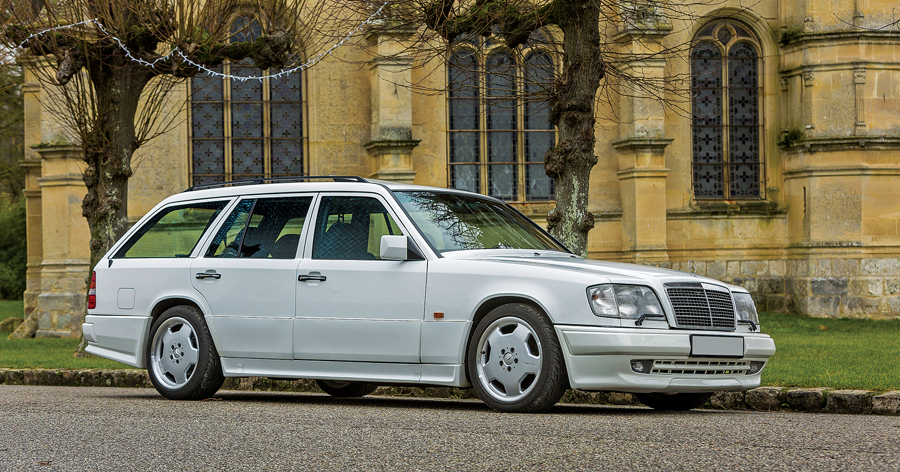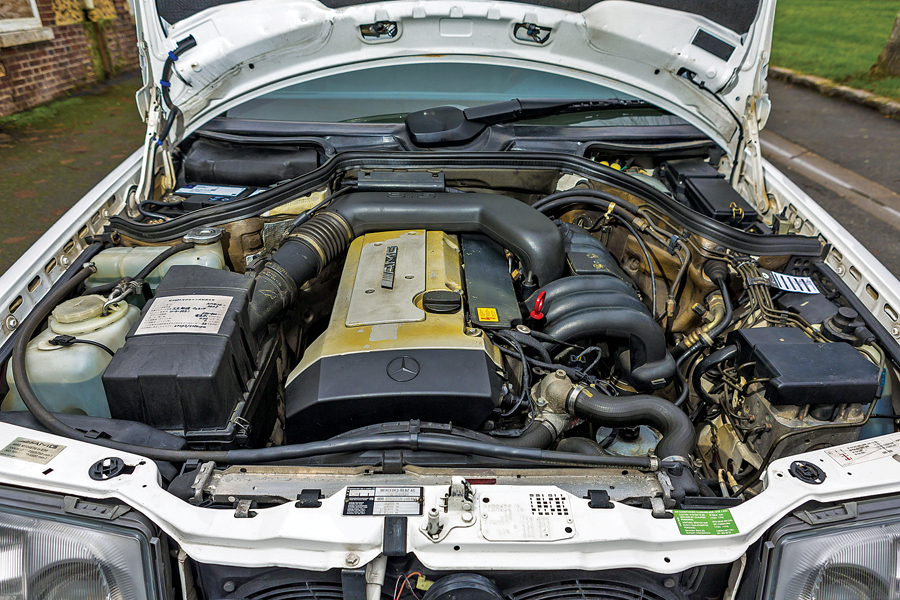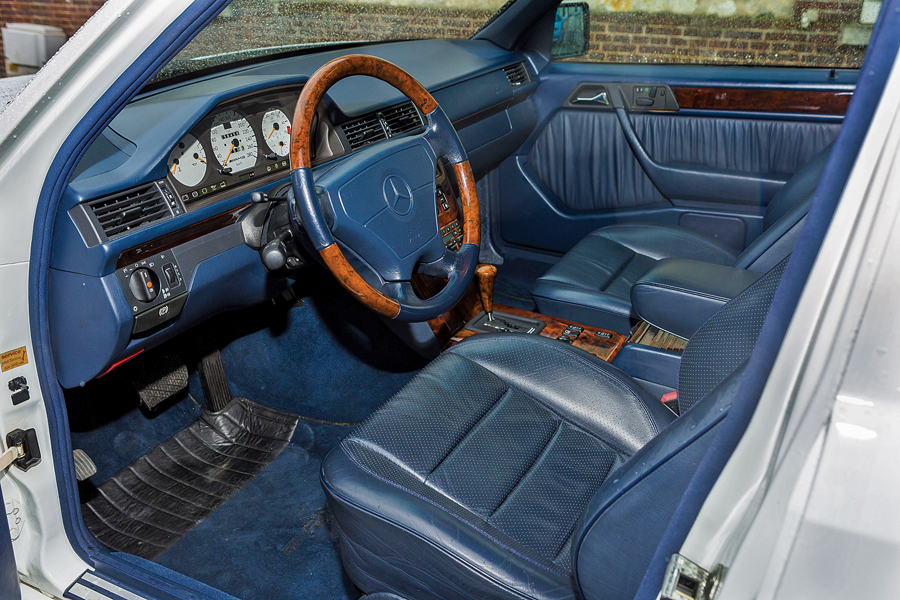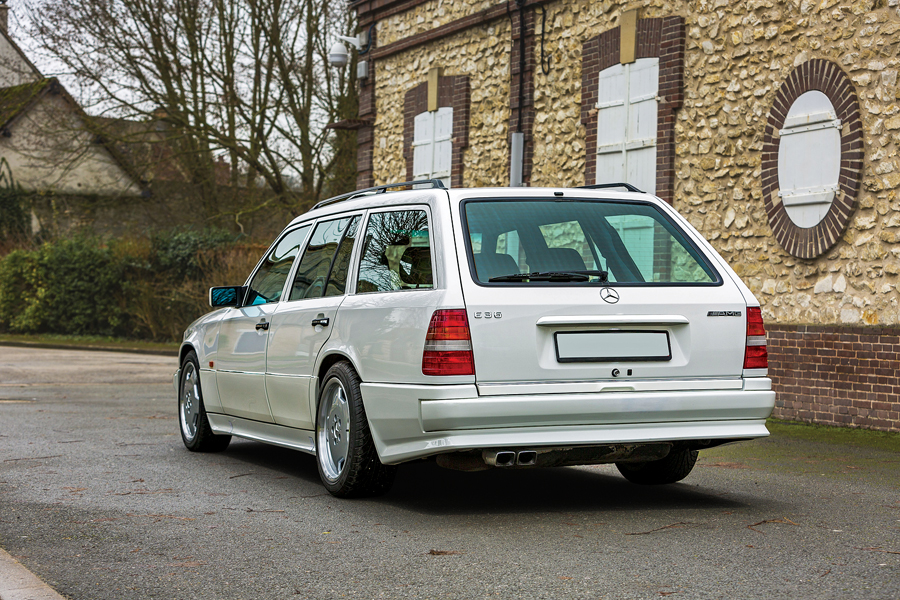SCM Analysis
Detailing
| Vehicle: | 1995 Mercedes-Benz AMG E36 Sports Estate |
| Years Produced: | 1994–95 |
| Number Produced: | 171. More conversions were carried out after the fact |
| Original List Price: | $47,500 (1995 E320 wagon) |
| SCM Valuation: | $67,076 (this car) |
| Tune Up Cost: | $900 |
| Chassis Number Location: | On front firewall in front of battery compartment |
| Engine Number Location: | Rear left side of cylinder block |
| Club Info: | Mercedes-Benz Club of America |
| Website: | http://www.mbca.org |
| Alternatives: | 1989–95 BMW M5 wagon, 1990–92 Vauxhall Lotus Carlton, 1990–94 Volvo 940 turbo wagon |
| Investment Grade: | C |
This car, Lot 432, sold for $66,222, including buyer’s premium, at Bonhams’ Grand Palais sale on February 8, 2018, in Paris, France.
This car was not born as an E36. In fact, there was never a factory E36. Let me explain. All Mercedes are designated by a six-digit chassis code. The first three digits represent the platform, and the next three digits designate the specific model.
Our subject car’s VIN is 1240881F310186, indicating that when it left the Daimler Benz factory, it was nothing more than a 124088. In layman’s terms, this was a simple, practical W124 E280 station wagon. It is very likely that this car was exported to Japan, where AMG’s Japanese workshop carried out the E36 conversion. Because AMGs converted outside of Germany are perceived as less authentic, this makes the sales price even more baffling, even to AMG enthusiasts. Thus, there’s an underlying question we need to ask outselves: Why would anyone pay $66,000 for a 23-year-old Mercedes wagon?
The case for an aging Mercedes wagon
Modern Mercedes do two things extremely well: They are generally pretty quick, and they protect their occupants (all of them, not just the driver) much better than any other vehicle.
For these two reasons, I can’t blame anyone for wanting to drive one every day.
Sadly, just like almost all modern luxury brands, the modern Mercedes is loaded with gimmicks. In fact, if you asked me to pick a disparaging adjective to describe any modern Mercedes, it would be “gimmicky.” Besides performance and safety, they don’t really offer anything else.
Because Mercedes-Benz refrained from gimmick-driven marketing for so long in their illustrious past, today’s cars shine a more-positive light on older models.
Classic Mercedes are straightforward and engineered with much more clarity. Everything can be diagnosed, repaired and adjusted. These fine automobiles have a dignified presence, an unmistakable identity.
All models, from the W100 to the W201, were well thought out and styled with the same distinction throughout the decades.
While not perfect — and sometimes quite needy — these older Mercedes have survived so well because of their ease of repair and durability. Our subject car is one of the final variants of the last timeless platform — the W124.
Perhaps this explains why, as if it were triggered by a universal impulse, a surge of recognition has arrived for boxy Mercedes sedans and wagons from the 1980s and early 1990s. The W124 is no longer just a used car. The realization of the overused verse “they aren’t making any more” has finally sunk in.
We are entering a period in the timeline of Mercedes collecting where analog is favored over digital — and innovation is eschewed for functionality.
And the last shall be first
In addition to being the last version of the W124, our subject car is among the last of the AMG models that were developed without Mercedes’ control. After this, with cars like the C36, production techniques were standardized, and Mercedes began to make decisions for AMG. It is also the last Mercedes with an analog key.
For those of us with a love for performance station wagons, this was also a first. The E36 was the first mass-produced AMG wagon — if you can call about 170 units mass production. While there were other notorious W124 wagons, such as The Hammer, the E36 was designed as a model with factory support. This was a practical car — designed for daily use and high mileage. From here on, every Mercedes model platform that included a station wagon got an AMG variant.
Good but not the best
We are currently in a market where the big, important Mercedes-Benz cars have enjoyed dramatic appreciation. This means that enthusiasts who want an interesting entry into classic Mercedes ownership have to turn over a few rocks.
The really important W124s, which include AMG Hammers, the 500E, the E60 and pristine E320 cabriolets, have appreciated dramatically. So naturally these lesser-known E36 variants (coupe, sedan, wagon, cabriolet and the W463 G36) have started to attract greater buyer interest.
Still, buyers need to be careful.
Despite the fact it is an infinitely repairable car, the E36 has a few little problems. The head gaskets on M104 engines have a propensity for oil leaks, and this happens a lot sooner on the 3.6-liter AMG version.
Engine fuel-injection harnesses, alternator and starter harnesses and throttle actuator harnesses were eco-friendly failures. Many extremely low-mileage cars suffer from reliability issues because of deteriorating harnesses.
While the automatic climate-control systems on these cars worked well, the a/c evaporators can — and will eventually — fail. Mercedes also deliberately overloaded the reverse piston-release spring on the 1990 and later version of the 722.3 gearbox, making reverse failure possible.
For those who want a Mercedes wagon for the sake of owning a Mercedes wagon, buy a W123. They are much more robust and don’t have any of the previously mentioned issues. This E36 fits in better with someone who is building a collection of significant AMG products.
Build it yourself
The really neat thing about this car is that you can build the E36 AMG wagon yourself. You’ll need a decent E320 Estate and a clapped-out C36 sedan, but the M104 engine was basically the same between the two of them.
While the transmission in the E320 is up to the task, some suspension parts and brakes from the 500E can endow the E320 wagon with the driving experience of the E36.
Despite its humble origins as an E280 T, our subject car is more than a parts-bin special. Its AMG documentation accounts for about 80% of its selling price — the rest being that it is a well-preserved W124.
While its Japanese history (parts for these cars are scarce in Japan) suggests it may need some mechanical help to make it 100% (show me a Mercedes from Japan that doesn’t need any work, because I haven’t seen one yet), it’s still a winner.
Believe me when I say this sale is a sign of things to come. This car is slightly well sold today, but the purchaser will feel good about his decision in a few years, as modern Mercedes depart further and further from the purposefulness of the company’s past halo-model platforms. ♦
(Introductory description courtesy of Bonhams.)



